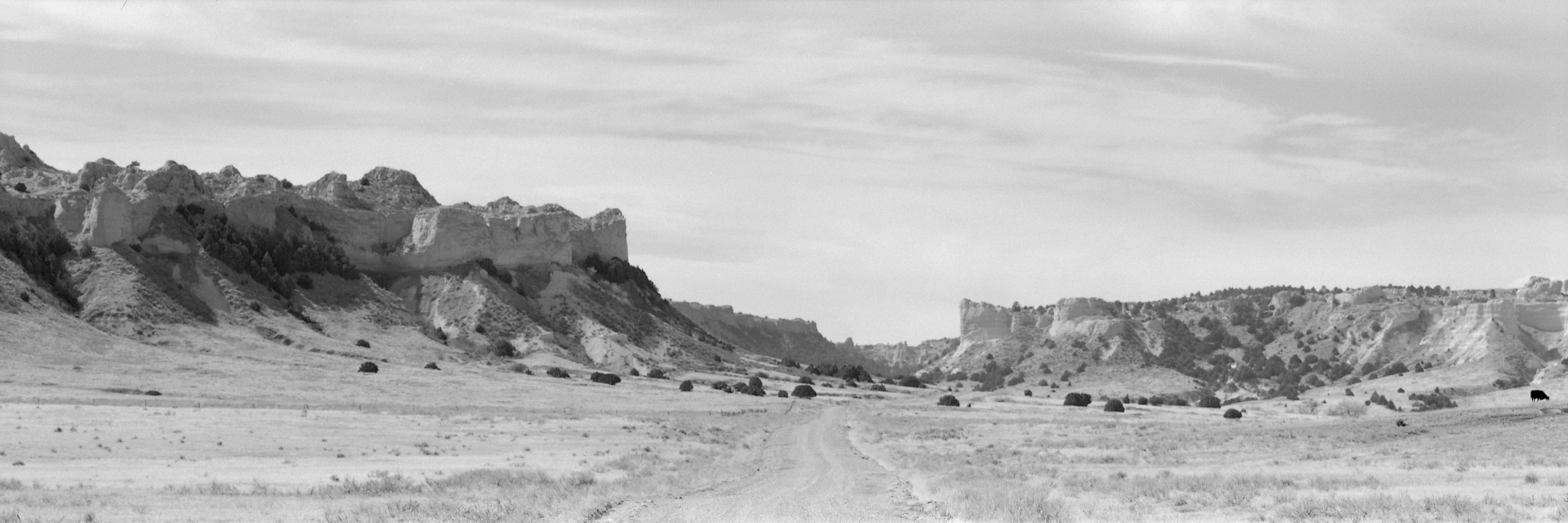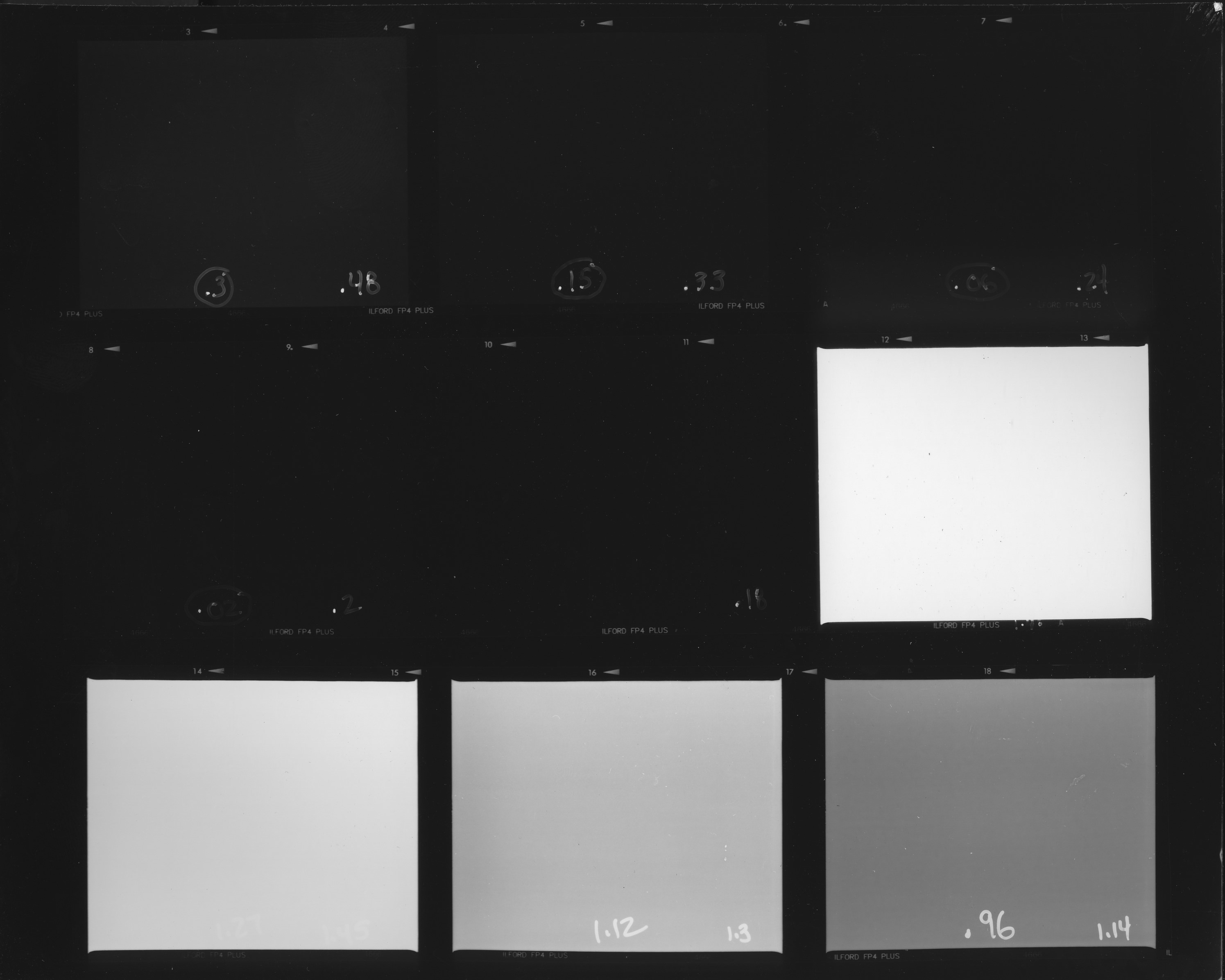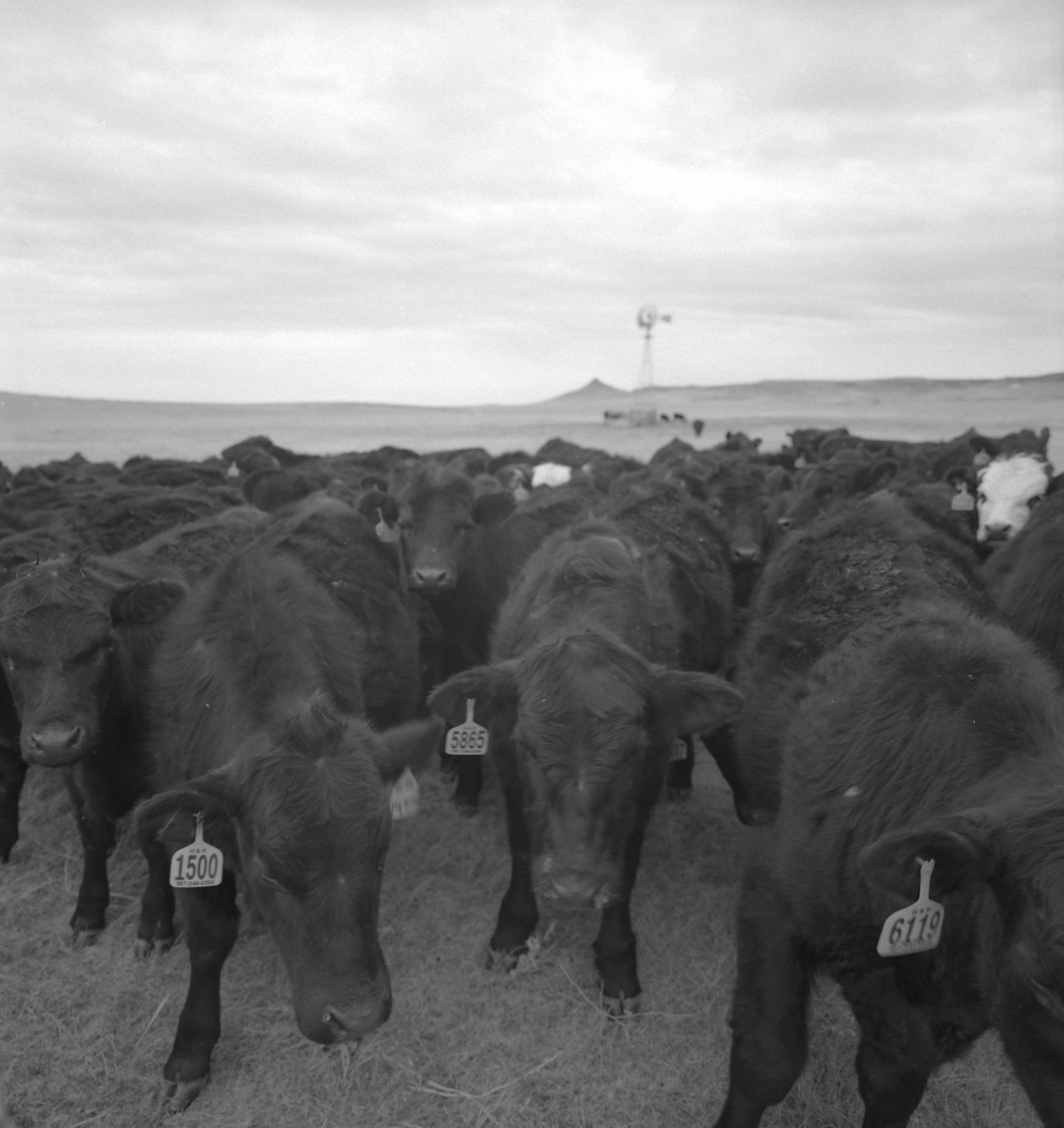Craig Pindell

Has Ilford Cured The Measles?
Executive Summary:
I tested 8 rolls of Ilford FP4+, Batch
#FF612/2, Expiration 03/2024.
My film speed and development time
test established the film speed for my process is ISO 100, and
development time in Ilford DD-X, diluted 1:6, is 10 minutes (after field
work this was modified to 9 minutes) at 68 degrees F.
The film has a smoother finish than previous
FP4+. The frame number printing on the backing paper is darker and
easier to read.
Overall, the film was every bit as beautiful and
forgiving as it ever was, and best of all, there was not a single
indication of the defects that came to be known as the “Ilford Measles”.
Kudos to the Ilford R&D group, and to Ilford as
a whole. It has been a long journey for the company and the results show
the commitment and capability of the premier company in film
photography.
My opinion is that Ilford has done what the
World Health Organization could not do, they have cured the measles.
Background:
I have been outspoken on Twitter and on my
web site concerning my frustration about the quality issue with Ilford
120 roll film, especially with my favorite film of all time, Pan F+. I
had a few email conversations with the technical folks from Ilford,
which seemed to me to be very unproductive.
I eventually stopped using Ilford
film, including sheet film and roll film. I wanted to be able to use one
film for all of the formats I use, and not being able to use Ilford for
120 was a deal breaker for me.
I spent a lot of time and money testing other
films and different film and developer combinations. When I finished, I
found a couple of replacement options, but I was not as enthused about
them as I had been Ilford products.
I also stopped ordering other Ilford products
when I used up what I had on hand.
I have used Ilford fiber paper for
more years than I can remember, and finding a suitable replacement was
nearly impossible. I kept printing, but wondered if the prints couldn’t
be better if they were on Ilford.
The Announcement:
On March 14, 2022, I read an announcement from
Ilford about the issues with the 120 roll film that gave me hope for the
future. I thought it was one of the best statements from them since the
problems began.
From the Ilford web site:
In March 2020 we issued a statement in relation to instances of spots /
mottle affecting a small percentage of 120 roll film negatives.
The quality of our products and the satisfaction of our customers is
paramount and something the ILFORD name has been built on for over 140
years. Our R&D team were tasked with resolving this issue and so we
would like to update you as to what they have been up to.
With your help we have been able to more accurately track and identify
instances of spots / mottle on our 120 films. Your feedback has, and
continues to be, a great help in enabling us to build a better
understanding of the issue and, more importantly, has allowed us to put
in place a range of corrective actions over the last two years.
Many of these actions focus on the handling of our 120 films as the
problem often arose or was exacerbated by heat, humidity and film age.
These have included additional production environment controls in
manufacturing and advisories for our global distribution network for
shipping and storage. We have also implemented a number of important
changes to make the films more robust as well as refinements to our
wrapper production coating and substrates.
All of these incremental changes were successfully phased into our
operations with each requiring a period of in-depth testing.
We are pleased to say that as a result we have continued to see
significant improvements in the stability of our 120 films in our
extreme testing conditions and no detrimental impact on their
performance or characteristics. We therefore expect the number of
instances of spots/mottle to further reduce as the films continue to
work their way through our worldwide supply chain.
I thought this was great news, and was looking forward to hearing from
other photographers about their results going forward. My feeling was
that sometime in the future, I might try Ilford again, but was not
rushing to buy film anytime soon.
A Surprise:
4 days after the announcement, I received a direct message on Twitter
from Michelle Parr at Ilford.
Hi Craig. I hope you're keeping well. I wanted to ask whether you would
be interested in testing some of the latest 120 rolls (FP4) that have
just come off production? I know that you have several issues with the
dreaded measles in the past so will totally understand if you don't want
to do this.
I considered it for a few minutes, then contacted Michelle. I was ready
for a break from the project I was working on, and was anxious to use
Ilford again. We worked out the details and Michelle sent me 8 rolls of
“new” FP4+.
I knew from using Ilford films in the past, they all work great with
DD-X developer, so I ordered fresh Ilford DD-X developer, Ilford
IlfoStop stop bath and Ilford Rapid Fixer from Freestyle Photo, my usual
supplier.
I double checked with Michelle to see if there were any parameters for
the test, and she told me to use it as I normally would. I knew the
conditions that were most likely to show the issues in the past, so I
planned to test the film in those conditions, as well as under exposing,
and under developing.
About Me:
I worked for many years in different manufacturing and industrial
plants. Before I started my consulting company, I was on the Global Risk
and Reliability Team for a world-wide manufacturing company. My group
went from plant to plant addressing issues that impact production and
quality. As a consultant I worked with large companies helping them to
resolve the issues that arise in manufacturing, with my area of
expertise being around Maintenance and Reliability.
I certainly have no way of knowing what problems Ilford had in
their process, but I do know from personal experience that when a
company has an issue with a previously dependable system or process, it
can be incredibly difficult to identify and correct.
I had been vocal about wanting more information from Ilford during the
measle problem, but I knew that I was only a customer, not a shareholder
of the company. While I had a stake in the resolution of the problem, I
did not have an ownership interest in the company. Even though I have
helped large companies resolve manufacturing issues, I was no position
to know what the problems might have been or to even guess what Ilford
may have to do to correct the issue.
Many of the comments on social media seemed to imply that the customers
were entitled to the details of the process, but that was not the case.
We all need to accept that we may never know the details of what Ilford
did to resolve this issue. We need to appreciate that they did the work
instead of quitting the 120 film business.
My Plan:
The first roll would be used for a speed and developer time test. This
is the test I do with every new batch of fill I use. I prefer to buy
film in large quantities so that I only have to use one roll for each
batch to test speed and development times.
I planned to use the Da Yi 617 back on the Bomm 8x10 camera, the 6x12
Horseman back on the Linhof 4x5 camera, the RB67 and the Hasselblad
camera. All systems I use frequently and trust.
The film will be developed in my Jobo CPE. The Jobo is my preferred
development system for many years. The Jobo is a rotary processor that
has always provided even and consistent development.
Pre-wash was for 5 minutes. I always pre-wash black and white film prior
to development.
Development will be in Ilford DD-X but rather than the 1:4 dilution
suggested by Ilford, I use a 1:6 dilution. This helps control the
highlights for me. I also had used this dilution when I had issues with
the measles in the past.
Stop Bath and fixer were used as directed by Ilford.
Washing was in a Calumet roll film washer.
First Observations:
When I was loading the film for the speed and development time test, the
first thing I noticed when I opened the foil envelope was a different
smell. It reminded me of the smell when walking into the press room at a
newspaper. It is not offensive; it was just different. I opened an old
roll of FP4+ that I had but didn’t use because of the chance of measles.
The two rolls smelled different.
When I was loading film in the Da Yi back, I immediately noticed the
frame number printing on the paper backing is clearer and a bit darker.
This is a very welcome improvement to any of us that use the frame
numbers on the paper backing. I confirmed this by comparing to the
backing paper from the old roll of FP4+ that I had. Over the past
several years, the frame number printing on Ilford roll film had gotten
lighter and lighter, making it difficult for us old folks with aging
vision, especially in low light situations.
After I exposed the film speed and developing test, I went into the
darkroom to develop the roll, and I immediately noticed the film was
smoother, to the point of feeling slick. Unrolling it from the back
paper, I could feel the difference, and then when I spooled the film
onto the Jobo plastic reel, the difference was even more obvious as the
film easily slid onto the reel. I compared the feel to my old roll of
FP4+ and the difference was significant.
When I dumped the pre-wash water from the first roll, I could see the
water was different color that what I expected. The water was a
purple-blue-dark grey color. In the past, FP4+ pre-wash water had been a
dark green- dark grey color. I used an old roll of FP4+ to confirm this.
Each of these observations led me to believe that Ilford made
significant changes to address the measles problem and were not just
hoping that improved quality control would be the answer.
Film Speed and Developer Test:
I had no reason to believe that Ilford would have created a new emulsion
for FP4+. If they had done that, I suspect it would have been called
FP5. I thought I would find the speed and development time was exactly
what I had used with the FP4+ that had problems, but I wanted to be
sure.
I loaded the roll of film in the RB67 with a 127mm lens. I focused the
lens at infinity and photographed a medium grey card in diffused
sunlight (The shady north side of my garage).
Exposures were:
1-
Zone I at ISO 32
2-
Zone I at ISO 64
3-
Zone I at ISO 125
4-
Zone I at ISO 250
5-
Blank frame, lens covered
6-
Zone VIII at ISO 32
7-
Zone VIII at ISO 64
8-
Zone VIII at ISO 125
9-
Zone VIII at ISO 250
I then developed the film in DD-X, diluted 1:6, at 68 degrees F, for 10
minutes (I use Ilford’s suggested times for DD-X even though I use a
different dilution.)
When the film was dry, I used my densitometer to read the densities for
each frame.
The Zone I exposures determine the film speed, my target is .10 to .12,
and that density was between exposure 2 and exposure 3. As I expected my
film speed was ISO 100.
The Zone VIII exposures determine the development time. My target
density is 1.20 to 1.30. I had determined the film speed to be ISO 100,
so checking the density between exposures 7 and 8, I found that the
development time was correct for ISO 100. (This provides me a starting
point; I reduced this time to 9 minutes after the second day of
shooting.)
I was pleased to see that this test did not have any indications of the
measles. In the past I saw the problems when doing this simple test.

The Film Speed and Development test contact print.
I know the film speed and development time, so it is finally time to
test the film.
Time To Create:
I went to a small town about 45 miles away from my home. I loaded the Da
Yi 617 back for the Bomm 8x10 camera. I wanted to make a photograph of
the Hawk Springs Wyoming post office. I had made this photo in the past,
and had it ruined by measles multiple times. The image would include sky
area and a triangle of the street in front of the buildings. In the
past, the measles would show in the sky and street.

Hawk Springs Wyoming Post Office
I also went to a canyon not far from Hawk Springs, and using the same
camera I photographed the road leading to the canyon with a lot of sky
in the composition. I knew the sky would be a magnet for measles if
there were any.

As I drove back home, I came across an area that had land farmed in an
interesting pattern, and I knew that the light areas of the farmed
areas, and the sky area would show measles.

I went home and developed the film. There is absolutely no indication of
measles anywhere on the film. I am still surprised at the slickness of
the film and the smell. It is really easy to load the reels. So far,
this film was ticking all of the boxes for me.
The Next Trip:
A few days later, I traveled north from my home to photograph at the
Guernsey Wyoming State Park. On the way, I saw a windmill some distance
off of the road that had a small herd of cows around it. The overcast
gray sky might be a way to show measles, if there are any, and the dark
cows would be an underexposure challenge.

After I made the photograph that I had envisioned, a larger herd of
cattle saw me by the fence and came to see if I had food for them. I
decided to photograph them as well, even though I knew the Bomm 8x10 was
probably not the best equipment for photographing moving cattle. The
previous image was underexposed on purpose, but for the close group of
cattle I did not remember to adjust the exposure, so both of the these
are under exposed.

The cattle continued to hang around the fence where I was, so I used the
Hasselblad SWC to photograph the cattle closest to me, with the windmill
in the background. I had already loaded the film into a back and had
photographed the valley on the previous trip. I ended up finishing the
roll on the cattle by the fence, because the SWC viewfinder wasn’t very
accurate, and the cattle were moving quickly.

I drove on to Guernsey State Park, even though it was very cold, windy
and there were snow flurries. I went to a picnic shelter in the park
known as the Castle. I knew the wind wouldn’t move the stone structure.
I composed the scene to have a full range of tones, from black to white,
knowing the measles would show themselves at someplace on the image, if
they were going to appear.


I went back to the darkroom that evening and developed the film. I was
sure that if there were measles I would see them on the day’s work, but
there was nothing. At this point I was becoming optimistic. Ilford FP4+
has always been a fantastic medium speed film, (except for the measles)
with terrific tones and fine, even grain. Maybe it is because I had not
used it for a while, I am again smitten with this film. It is beautiful.
The Last Shooting Day:
At this point I could have felt comfortable buying and shooting Ilford
film again, at least the FP4+. I had not seen a single issue and the new
feel and the better backing paper printing were terrific. I decided to
stress the film and see if I could create problems. On one hand I felt
it was good to push the envelope, but on the other hand I wondered if I
was being unfair to the Ilford folks by using their guidelines to cause
a problem. In the end, I decided to over expose and under develop the
film, and though it was not intentional, I overheated the film.

I went to Hawk Springs Reservoir, not far from my home. It was a bright
sunshiny day, with no wind, and no clouds. The sand and water were
bright and I went to an area of the reservoir that had many dead trees
that had shed their bark. The bright wood against the blue sky made good
contrast, which I accentuated with red or orange filters.

I knew from my measles issues in the past that cloudless sky
photographed with an orange filter would be an invitation for measles. I
used my Linhof camera with a Horseman 6x12 back and wide-angle lenses to
include more sky. In order to further stress the film, I loaded the back
in full sunlight. There were absolutely no issues. This back was also
very hot during the day, but the film did not exhibit a single problem.

I also made a few images with the RB67 and the 50mm lens, with an orange
filter of the same trees. While I was walking around the beach, the sun
shining on the camera raised the temperature considerably. The camera
was hot to the touch. Normally I would have put a dark cloth over the
camera, or moved to the shade, but as an impromptu part of the test, I
decided to let it get hot and see how the film did. I did not see a
single problem.

In Conclusion:
The film performed very well, and there was not a single indication of
any defect. I don’t want to tempt the photography gods, but this film
seems to be measles free. Because of the slicker feel and the smell, I
think Ilford made some significant changes, and I suspect they did much
more testing than I have. Ilford has no reason or responsibility to tell
anyone what changes they made, but I am glad they attacked the problem
and made the statement letting us all know they feel they solved the
problem.
The slick feel really helps loading on plastic reels, and the better
printing on the backing paper is a true bonus. Ilford has been a
long-time anchor of the photography industry, and it is not surprising
they tackled this problem head on. Ilford has not only endured when many
other companies have downsized or quit film photography completely, they
have added products and improved existing products.
Resolving this issue may have taken longer than any of us wanted, but we
need to remember there was a global pandemic involved in the timeframe.
It could not have been easy to try to brainstorm and problem solve
something this serious over zoom.
After using these 8 rolls of film, my opinion is that I will be buying
Ilford again. I feel the problem has been solved and until I see a roll
with measles, I will be again be an Ilford loyalist. Ilford films have
long been second to none, and I am anxious to use the materials that
provide me the best finished product. I was able to confirm with
Michelle that the changes were being implemented on the other 120 Ilford
films as well, so I will be restocking in
a big way, especially the beloved Pan F+.